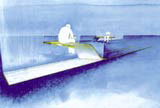Newcastle Blue Carpet

This was a job won in an international competition in 1996, primarily against architects and artists, and was Heatherwick’s first big break. The job is to make a public square, a rich and unusual civic space, out of a pedestrianised area of what was once a wide main street. Heatherwick won out with another of his ideas that looks conceptually simple, but is, in fact, highly complex to produce. He proposed a ‘blue carpet’ for the square, in which the paved surface would lift and curl at certain points to provide seating and various other items of street furniture. Where the ‘carpet’ lifts, treasures of one kind or another, exotic or prosaic, can be revealed beneath.
‘Have you seen the fibre-optic paving?’ asks Heatherwick, and we go into the computer room at the back of the workshop. Space being tight, this is not only where the computers live (away from the dust of the workshop), but also a store room for odds and ends. Among these are samples of paving with an iridescent blue-green finish, made with recycled glass. Other samples are perforated with holes, in which the fibre-optic cables will terminate. The idea is that the surface will glitter at certain key points where the magic carpet is peeled back. In the workshop out the front, one of Heatherwick’s team is making the complex curving timber buck which metalworkers will use as a template for the seating frame.
Meanwhile, he is dreaming up treasures to reveal, beneath armoured glass, where the surface peels up. These might include water mains, a section of long-hidden city wall, and (if he can get the art gallery to agree) a full-size Victorian portrait, laid horizontally and glimpsed only at one corner. It sounds like exhibition design – but out in the rough and tumble of the public realm. ‘It’s got to be very tough – the guerillas are out there,’ he observes. ‘Besides, you’ve got to be able to drive a ten-ton fire engine over it.’ Not only that, but like any bit of public thoroughfare, it has to be capable of being dug up. This is no place for designer preciousness.
And the bespoke and mysterious things in the square must, insists Heatherwick, be juxtaposed with the absolutely normal. Although he is designing specialist bollards to emerge like budding plants through slits in the ‘carpet’, he does not want purpose-designed street lighting, for instance – he likes the basic type in the same way that he likes NHS spectacles. Similarly, where the materials of the new square abut the paving of the streets around, that paving should be made of standard concrete slabs, nothing fancy. ‘Where do you stop, otherwise?’ he wonders. Mind you, he has redesigned an escape staircase from an adjacent hotel which drops down into his square. Once again based upon a twisted timber support, it is kept low-key, even municipal, so as not to draw attention away from the main event.
The tenders for the project had just come in at the time of interview – and they were over budget. More delays and problems. But Heatherwick remains cheerful. He has got used to negotiating ways to get his designs achieved. Early on he persuaded his client in Newcastle to invest in the most mature trees possible along the edge of the square – just to screen the area from the roaring buses which turn a corner right beside it. ‘A big part of our role,’ he notes, ‘is problem solving.’
-
Post a comment




